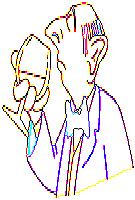|
WineTrader TOP |


Restaurateurs: Where are the Great Wine Lists? | |||
 Whatever happened to wine lists that people could read with some level of dignity? I'm not talking about selection or by-the-glass or magnums. I'm talking about a list of wines that you could pick up, open and make a selection without needing glasses, the modern encyclopedia of wine or a master sommelier to feel safe. I mean a wine list that had a nice appealing cover. A wine list that was clean and didn't look like a Roman relic. A wine list that was not written in Sanskrit. A wine list like the ones that made America great! I have some observations to make on wine lists I've been handed in restaurants. I have to admit that for all the advances in wine and food appreciation in the last decade the wine list seems to have been forgotten. I suppose that this could be a reaction to the huge tomes that seemed to be the norm in the 60's and 70's. I could categorize current wine lists by percentage: Great (10%), Good (20%), Average (20%), Below Average (20%), Would Confuse Einstein (20%), Conceived by Patients in a Mental Institution (10%). And this is supposed to be a tool to make your dining experience easier! What would I look for in a great wine list? Good question, since I was one of the originators of the World Atlas Wine List. But times change as has cuisine, ambiance and service styles. I would look for these factors when a waitperson or sommelier handed me a wine list:
Just read the latest "Trader", and couldn't help but read your Letters' section. I just wanted to clarify your comments regarding the M.S. & M.W. titles with a little more detail. What you say is by and large accurate, but perhaps incomplete. The M.W. Exam is a written exam, and it is geared to all wine professionals, the majority of whom are NOT in the brokerage trade or journalists. Most are buyers, several are writers, a few are consultants, etc. More to the point. The exam comprises both a theoretical section taken over 4 days whose questions must be answered in essay form, a double blind, practical tasting exam over three days, with three dozen wines, plus an original dissertation that comprises 20% of the total exam value. There are currently 218 active M.W.'s worldwide, dating back to the first M.W.'s in 1953, and including 11 new M.W.'s from the class of 1997. The pass rate is close to the numbers given in your response, but does vary year to year, the highest has been 20%. Space and time permitting, I hope you will publish this note for your readers' knowledge.
Regards, Dear Joel, I agree, Joel, but want to clarify the notation that most M.W.'s are not journalists or in brokerage. First of all, the M.W.'s whose names most people would recognize are writers. The second is that when I say brokerage trade I mean purchasing, selling, promoting wines in the general market or through distribution or export/import channels. This is to broadly define their activity versus Master Sommeliers who have a hospitality background and are mostly involved in dealing with the on-premise trade. Fred Dame, M.S.
The Wine Curmudgeon © Copyright 1997 Jerry D, Mead, JDM Enterprises and Wine Investigation for Novices and Oenophiles; all rights reserved.
| |||
